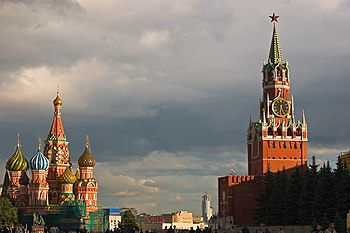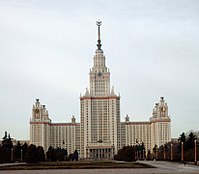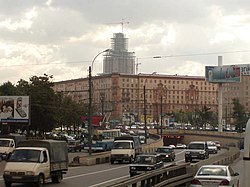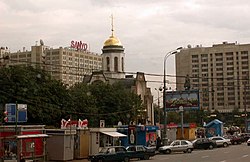Moscow
From Wikipedia, the free encyclopedia.
- For other uses, see Moscow (disambiguation).
| Coat of Arms | Flag |
|---|---|
 |
 |
| Data | |
| Federal District: | Central |
| Subdivision: | Federal city |
| Location: | 55°45′ N 37°37′ E |
| Area: | 1,081.00 km² |
| Population: | 10,409,200 (within the city area, 2005) |
| Population density: | 8,537.2 persons/km² |
| Altitude: | 150-200 m |
| Postal code: | 119992-123182 |
| Dialing code: | +7 095, +7 499 |
| License plate: | 77, 99, 97, 177 |
Moscow (Russian: Москва́, Moskva, IPA: [mʌ'skva] listen ▶(?)) is the capital of Russia, located on the river Moskva. The urban area constitutes about 1/10 of the Russian population, thus making it the most populous city in Europe.
The city is in the federal district located in the west of Russia. It was the capital of the former Soviet Union, and of Muscovite Russia, the pre-Imperial Russia. It is the site of the famous Kremlin, which serves as the center of the national government.
Moscow is also well known as the site of the Saint Basil's Cathedral, with its elegant onion domes. The Patriarch of Moscow, whose residence is the Danilov Monastery, serves as the head of the Russian Orthodox Church.
Contents |
History
- Main article: History of Moscow
The first reference to Moscow dates from 1147 when it was an obscure town in a small province inhabited mostly by Merya, speakers of a now extinct Finnic language. In 1156, Prince Yury Dolgoruky built a wooden wall and a moat around the city. After the sacking of 1237-1238, when the Mongols burned the city to the ground and killed its inhabitants, Moscow recovered and became the capital of an independent principality. Its favorable position on the headwaters of the Volga river contributed to steady expansion. Moscow was also stable and prosperous for many years and attracted a large numbers of refugees from across Russia. Under Ivan I the city replaced Tver as capital of Vladimir-Suzdal and became the sole collector of taxes for the Mongol rulers. By paying high tribute, Ivan won an important concession from the Khan. Unlike other principalities, Moscow was not divided among his sons but was passed intact to his eldest. In 1380, prince Dmitry Donskoy of Moscow led a united Russian army to an important victory over the Mongols in the Battle of Kulikovo. After that, Moscow took the leading role in liberating Russia from Mongol domination. In 1480, Ivan III had finally broken the Russians free from Tatar control and Moscow became the capital of an empire that would eventually encompass all of Russia and Siberia, and parts of many other lands.

Moscow ceased to be Russia's capital when in 1703 Peter the Great constructed St. Petersburg on the Baltic coast. When Napoleon invaded in 1812, the Moscovites burned the city and evacuated, as Napoleon's forces were approaching on September 14. Napoleon's army, plagued by hunger, cold, and poor supply lines, was forced to retreat. In January of 1905, the institution of the City Governor, or Mayor, was officially introduced in Moscow, and Alexander Adrianov became Moscow's first official mayor. Following the success of the Russian revolution in 1917, Lenin, fearing possible foreign invasion, moved the capital from St. Petersburg back to Moscow on March 5, 1918. During the Great Patriotic War, the Soviet State Committee of Defence and the General Staff of the Red Army were located in Moscow. In 1941 16 divisions of the national volunteers (more than 160,000 people), 25 battalions (18,000 people) and 4 engineering regiments were formed among the Muscovites. In November 1941, German Army Group Centre was stopped at the outskirts of the city and then driven off in the course of the Battle of Moscow. Many factories were evacuated, together with much of the government, and from October 20 the city was declared to be in a state of siege. Its remaining inhabitants built and manned antitank defenses, while the city was bombarded from the air. On May 1, 1944 a medal "For the defence of Moscow" and in 1947 another medal "In memory of the 800th anniversary of Moscow" were instituted. On May 8, 1965 owing to the actual 20th anniversary of the victory in World War II Moscow was awarded a title of the Hero City. In 1980 it hosted the summer Olympic Games.
In 1991 Moscow was the scene of a coup attempt by Communist hardliners opposed to the democratic reforms of Mikhail Gorbachev. When the USSR was dissolved in the same year, Moscow became a capital of the Russian Federation. Since then, the emergence of a market economy in Moscow has produced an explosion of Western-style retailing, services, architecture, and lifestyles.
Administrative divisions
- Main article: Administrative divisions of Moscow.
Culture
Moscow is the heart of Russian performing arts, including ballet. Theatres and ballet studios dot Moscow. The most famous of these are the Bolshoi (Big) and Malyj (Small) theatres. Ticket prices were as low as $1 in the Soviet era, but have increased dramatically since.
Although less than a quarter of Russians live in the countryside, Muscovites, like other urban dwellers, are still attached to the country. Many live in country homes (called dachas) over the weekend and over holidays, and retire to the country when they are old. Moscow contains many parks and gardens; see Sport.
Education
There are numerous large universities in Moscow, including the renowned Moscow State University housed in the 240m high tower on Vorobyovy Gory (Sparrow Hills). The university has over 30,000 undergraduates and 7,000 postgraduate students. Bauman Moscow State Technical University offers a wide range of technical degrees. Moscow State Institute of International Relations [1] is Russia's best known school of international relations and diplomacy.
See Also: List of universities in Russia
Tourism
Moscow has always been a popular destination for more adventurous tourists. The better known attractions include the UNESCO World Heritage sites of the Kremlin, Red Square and the Church of the Ascension at Kolomenskoye, all dating from between the 14th and centuries. Other popular attractions include the Zoo, expanded in the 1990s. Moscow is also the western end of the 9 300 km Trans-Siberian railway to Vladivostok. The city is best visited in midwinter when the streets are cloaked in powdery snow and the dusky twilight of the continental winter. In winter the locals face the cold with the warm embrace of hospitality. However, as temperatures can often be below -25 °C (-13 °F), early summer or early autumn can offer a more comfortable, if less romantic, visit.
- Moscow tourist attractions
Bolshoi Theatre | Kolomenskoye | Kremlin | Poklonnaya Hill | Kuskovo | Manege | Europe's tallest tower | Stalinist skyscrapers | Ostankino Palace | Pushkin Museum of Fine Arts | Red Square with Lenin's mausoleum and Monument to Minin and Pozharsky | Saint Basil's Cathedral | Novodevichy Convent | Donskoy Monastery | Red Gate | Shukhov radio tower | Cathedral of Christ the Saviour | State Tretyakov Gallery | All-Russian Exhibition Center | Alexander Garden | Moscow Zoo | Patriarch's Ponds | Moscow State University | Krutitsy | Elokhovo Cathedral | Church of St. Nicholas of the Weavers | Church of St. John the Warrior | Menshikov Tower | Church of the Intercession at Fili
Views of Moscow
|
Stalinist Skyscraper at Kotelnicheskaya Naberezhnaja. |
Costs
Some prices are considerably higher for the foreign visitor than for locals. A cost of living survey by Mercer Human Resource Consulting puts Moscow in second place after Tokyo, making it the most expensive city in Europe. For natives, small apartments bought or given by the state in the Soviet era, coupled with extremely low utility costs and easily avoidable income tax serve to lower the cost of living greatly. A look at transport prices offers a good illustration. A taxi from Sheremetyevo International Airport will cost the non-Russian speaking traveller upwards of $60; the Russian speaking foreigner will be charged $30-$40. The native Moscow dweller will negotiate the price to $15-20 or will avoid the taxi rank altogether and take a shared taxi to the nearest metro station for about 0.5 dollar.
Dining
In recent times there has been a large and quickly growing range of restaurants with a range of prices to match. The average cost, per person, for a meal in a middle to high class restaurant will be $30 to $200, especially if one orders vintage wines. Chain restaurants, such as "Moo-Moo," offer adequate quality canteen food – with English menus – for around five dollars per person. Although most Moscovites do not eat in even cheap restaurants very often, lately many new "middle-class" restaurants have opened, targeting families on weekends.
A number of fast food restaurants have outlets near many metro stations. That includes the omnipresent McDonald's as well as other chains, notably Rostiks, which specializes on serving chicken, Kroshka Kartoshka, serving traditional baked potato with numerous toppings, Danish-style Stardogs! and many others. Recently, a large number of coffee shops have sprouted up around the city.
Transport
Moscow has five airports, Sheremetyevo International Airport, Domodedovo International Airport, Bykovo Airport, Ostafievo International Airport and Vnukovo International Airport. The city is also the main rail hub for Russia, with daily trains to diverse destinations such as Vladivostok (9 000 km) and Brussels (2 000 km) [2].
Local transportation includes the Moscow Metro, an excellent metro (subway) system famous for its art, murals, mosaics, and ornate chandeliers. Begun in 1935, the system has 11 lines and more than 171 stations. The system is the world's busiest, with 9 million passengers every day and trains every 90 seconds at peak times.
As Metro stations are placed quite far apart in comparison to other cities, up to 4 km, an extensive bus network radiates from each station to the surrounding residential zones. Suburbs and several city areas also connected with electric train (elektrichka) network. The buses are very frequent, often more than one a minute, and inexpensive at about $0.5. Every large street in the city is served by at least one bus route and none of the city's 13,000 apartment blocks are more than a few minutes walk from a stop. There are also tram and trolleybus networks.
There are over 2.5 million cars in the city on a daily basis (2004). Recent years have seen explosive growth in the number of cars, which caused traffic jams and the lack of parking spaces to become major problems.
The road system is structured with sequences of radial and ring roads. Boulevard Ring, repeats the former location of 16th century city wall and encircles what used to be called Belyj Gorod (White Town). Boulevard Ring is technically not a ring - it isn't connected and has a horseshoe-like shape. Garden Ring, the streets built on place of Earth wall, built in the end of XVI century around Earth Town, but replaced by boulevards after war of 1812 and later by wide streets during reconstruction of 1930's. The Third Transport Ring, and Fourth Transport Ring, is being constructed to reduce traffic congestion, on periphery. And a large road called MKAD forms the approximate boundary of the city.
Sports
Soccer is an extremely popular spectator sport among the young. Clubs such as Dynamo, CSKA, Lokomotiv and Spartak are prominent on the European stage. Supporter violence has become a serious problem when international teams play in Moscow. In 2002, a dozen Irish fans in Moscow for a Russia-Ireland game were attacked by neo-Nazi groups. One later died of his injuries. That same year, when a Russia-Japan World Cup match, played in Japan but broadcast live to the crowds in Pushkinskaja Square, went badly for the Russians, the crowd turned violent and wrought havoc in the centre of the city, breaking windows, smashing and burning cars and looting several shops. A Chinese restaurant was incidentally attacked and five Japanese tourists were beaten. One policeman died (other sources say two) and about one hundred people were injured.
Winter sports have a large following. Most Russians own cross-country skis and ice skates and there are many large parks with marked trails for skiers and frozen ponds and canals for skaters. Often parks will have small local businesses offering ski and skate rental. Prices range from $1 to $5 an hour for rental.
Moscow was the host city of the 1980 Summer Olympics, although the yachting events were held at Tallinn. Huge new stadium and other athletic facilities were built especially for the occasion. The main international airport, Sheremetyevo Terminal 2, was also built at this time. Moscow has also made a bid for the 2012 Summer Olympics. However, when voting commenced on July 6, 2005, Moscow was the first city to be eliminated from further rounds. The Games were finally awarded to London.

Demographics
Although the population of the Russian Federation declines by about 700,000 (143.8 million * 0.5% decline) every year due to low birth rates and early deaths, Moscow appears to be immune to these problems in recent years. Moscow has a very high population growth rate, largely due to migration (despite an internal passport system that makes it illegal for non-city residents to stay in the capital for more than 90 days without registration). These new Moscovites are attracted by the local economic growth rate of up to 20%, versus stagnation or even decline in most of Russia, the result of sharp polarization of the country in recent years. The city is home to small numbers of people of every racial and cultural group, from African students to Irish business people (there is an annual St. Patrick's Day Parade on the Novy Arbat avenue). However, the major part of the population are ethnic Russians, Tatars, Ukrainians and Belarusians.
According to a July 22, 2004 article in Forbes, Moscow became the city with the most billionaires. It had 33 billionaires, passing New York City by two.
- See also History of Moscow for historical population growth
Terrorism
As with many cities, terrorism is a threat in Moscow. On February 6, 2004 a bomb explosion in a subway car near the Avtozavodskaya metro station killed at least 40 and injured many. Other prominent acts of terror include the destruction of two apartment buildings in September 1999 (see Russian Apartment Bombings), an explosion in the pedestrian subway under the Pushkinskaya square in August 2000, and the capture of the theatre at Dubrovka in October 2002.
Media
Moscow is the headquarters of many Russian television networks, radio stations, newspapers and magazines. The following is a brief list, beginning with English-language sources, followed by Russian.
Newspapers
- The Moscow Times The largest English-language daily operating in Russia.
- The eXile Alternative biweekly known for its irreverent style, pranks and club/restaurant reviews.
- gazeta.ru Leading Russian web magazine. In Russian only.
- Vedomosti with Financial Times The leading Russian business newspaper.
Radio
- Echo Moskvy "Echo of Moscow", The first Soviet and Russian private news radio and information agency. 91.2 FM in Moscow, in Russian only.
Bibliography
- Karel Neubert. "Portrait of Moscow". 1964
- Albert J. Schmidt. "The Architecture and Planning of Classical Moscow: A Cultural History". 1989
- Kathleen Berton. "Moscow: An Architectural History". St. Martin's, 1991
- Marcel Girard. "Splendours of Moscow and Its Surroundings", trans. from French. 1967
- John Bushwell. "Moscow Graffiti: Language and Subculture". Unwin Hyman, 1990
- S.S. Hromov et al. (eds.). "History of Moscow: An Outline", trans. from Russian. 1981
- Galina Dutkina. "Moscow Days: Life and Hard Times in the New Russia". Trans. Catherine Fitzpatrick. Kodansha America, 1995
Further reading
External links
- Official Moscow Administration site
- Current time in Moscow
- History of Moscow
- http://www.bestofrussia.ca
- Moscow Life - Moscow Travel Guide
- Moscow Metro Photos - Panoramic Virtual Tour
- http://www.m2012.ru/en/
- Moscow - city guide to hotels, restaurants, museums.
- Moscow hotels directory
- Moscow Weather Forecast
- Red Square, Moscow Webcams
- Google Maps: Moscow (satellite images)




















